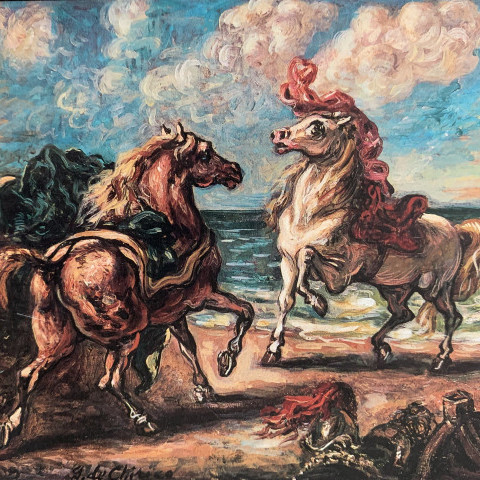Giorgio de Chirico was born in 1888 in Volos, capital of the Greek province of Thessaly. His parents were Italian, his mother a former operetta singer and his father a civil engineer who designed railroads in the province of Thessaly. When his father died in 1905, his mother took him and his brother to Munich where he studied at the Academy of Fine Arts, where he became devoted to Nietzsche and art which disdained the real world for fantasy and dreams. He was influenced by Max Klinger and especially the Swiss-German painter Arnold Bocklin. In 1909 de Chirico moved to Florence and in 1911 to Paris.
The young Italian was shortly caught up in the artistic turmoil of Paris. Through the influence of the poet-critic Apollinaire, he gained entry to the important annual art salons. He was represented in both the 1912 Salon d'Automne and the 1913 Salon des Independants; he won critical notice and began to work harder than ever. His style underwent surprising mutations. He abandoned the buxom nymphs and classical Greek style of Bocklin and showed affinities with cubism and other avant-garde currents that he was later to denounce.
De Chirico was the first artist to dwell on such seemingly arbitrary confrontations of inanimate objects. His work was unrelated to any "isms" and was a defiant rejection of the rest of modern art. This was the art that spellbound the young artists who emerged a few years later as the Surrealists. Max Ernst, Rene Magritte, Yves Tanguy, Salvador Dali and Andre Masson ll discerned in de Chirico's transformation of the ordinary the chief model for their own subversion of reality by dream, memory and association.
Most of his great pictures were painted before the outbreak of World War I, but at the end of the war, decadence started to set in. Gradually de Chirico turned from his radical style and obsessive visions to investigate the techniques of old masters like Rembrandt and Raphael, and in doing so sank into the flatulent "Renaissance" classicism he practiced until his death in 1978. He was only thirty-four at this time and unfortunately, he had neither the technical proficiency nor the mastery of drawing to reach his declared goal: a delayed place in the Renaissance tradition.
As time went on, vexing questions of authenticity and the problems of evaluation were raised by this man who looked backwards to his own youthful past through the odd practice of counterfeiting numerous variations of his acclaimed masterpieces. Hardly anyone in fifty years had a kind word for his later output. It was generally written off as the work of a self-plagiarizing bore.
De Chirico was a man of medium height, a bit stocky, always well dressed with impeccable manners. He had a melodious voice, unctuous, almost ecclesiastical, gestures and magnificent eyes. He was very generous, quite likeable despite his moody disposition. De Chirico was married twice. His first wife was Raissa Gurevich; the second marriage was to Isabella Far, who was called Isa. She was also his business partner and was responsible for the creation of a foundation which provided sole authentication of his work. She served as president of the foundation until she died in 1990, twelve years after her husband.
Source: askart.com

